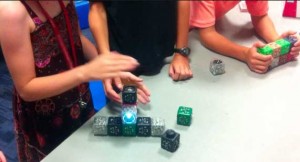We recently shipped out Cubelets kit number 100,000. It’s an arbitrary number, but I think cause for celebration. Something about another digit, an order of magnitude, reinforces that a hundred thousand is a pretty big number.
The notion that we’ve made 100,000 boxed Cubelets kits is a little baffling when I think back through our history. I started on the design of Cubelets as part of my PhD research (we called them roBlocks back then) at Carnegie Mellon University in 2006. Something about the little robot blocks caused imaginations to go into overdrive; one after another, people visiting our lab kept asking if I could make just a few more Cubelets; for their science center or children’s museum. After a visitor from Japan offered to pay a ridiculous amount of money for my (only) prototype set of Cubelets, we decided to try to figure out how to make more of them in a way that didn’t rely on me staying up all night soldering circuit boards.
Here’s one of my favorite videos from the Cubelets Museum. These were the first working prototypes of the design for mass production. I had just returned from a trip to visit our injection mold supplier in China, and brought back these black prototypes. I shot this video quickly on my desk, my friend Evan recorded the music, and I did a quick iMovie edit and posted the video. Yesterday, our COO Jon Moyes and I were talking about the feeling of wonder, and he mentioned how vividly he remembered seeing this video in 2011 and deciding that he wanted to work for Modular Robotics.
Even back then we were thinking about the future. I remember a conversation with Brad Feld, one of our Directors, where we discussed orders of magnitude for product lines. Back then, we posited that we’d make around 1000 Cubelets kits, then we’d parlay what we learned from that into the next product that we’d make 10,000 of (remember MOSS?). And that eventually, we’d figure out robot blocks and design a product that sold 100,000 kits. Here we are, eight years later, with 100,000 Cubelets kits out the door and increasing volumes each year. We didn’t see that coming.
From some perspectives, 100,000 is not a huge number. When I was a little kid, it was a big deal for a car to reach 100,000 miles. I remember when our big green Dodge van, Betsy, hit 100,000 miles. The van only had five digits on the odometer; reaching 100,000 caused it to reset to zero. But now some cars are making it to a million miles!
For us, though, 100,000 Cubelets kits (that’s around 720,000 Cubelets, by the way) feels big, and feels like a reason to celebrate. After all, the mission of Modular Robotics is to make the world a better place with thousands and thousands of tiny robots. Explicit in that is broad impact through scale. We see every day how Cubelets can help kids form thoughtful and accurate models of how the world works, and it feels like we’re on our way to helping create a critical mass of kids who can think about complex systems, networks, and emergence in ways that my generation clearly can’t.
Here’s our most recent Cubelets video. Some things have changed, but it’s surprising how much has not.
Tag Archives: Cubelets
As Space Shuttle Endeavor is transported to its retirement, my Facebook and Twitter feeds are flooded with comments and photos of its final flight. I can’t help but feel like this is, at some level, the end of an era. An era of big dreams and phenomenal achievements. An era of curiosity, exploration and discovery. It’s the end of an era of great things.


